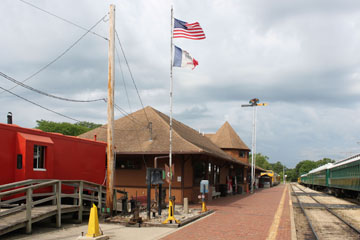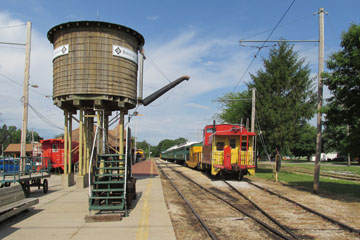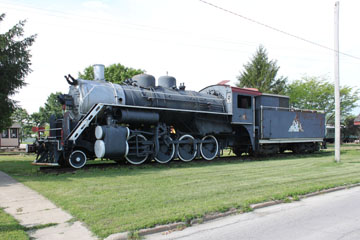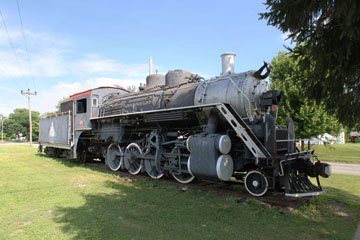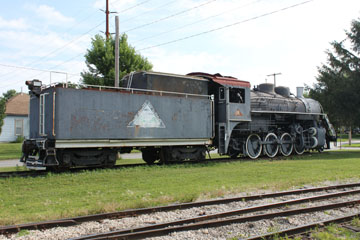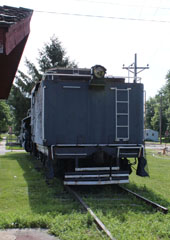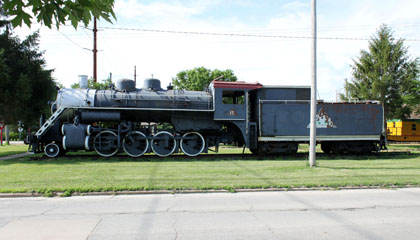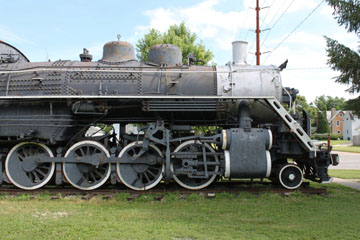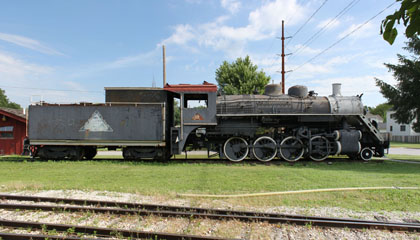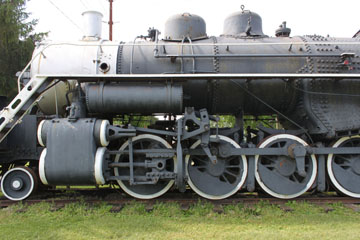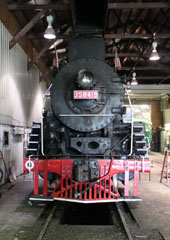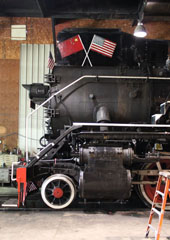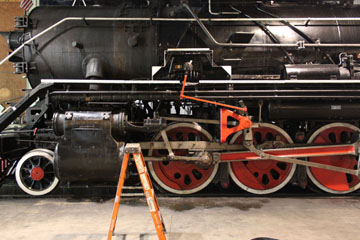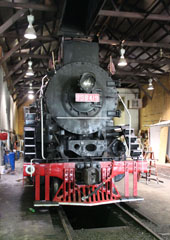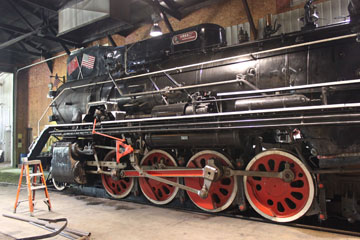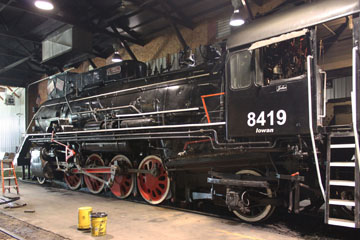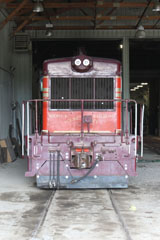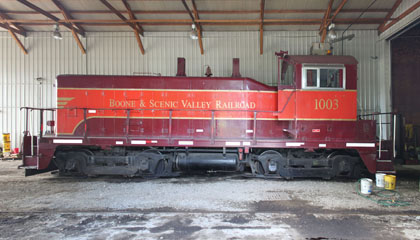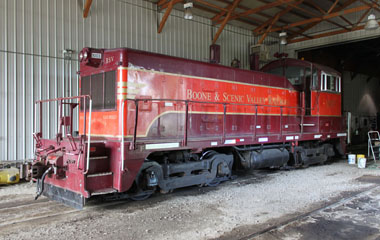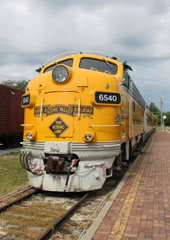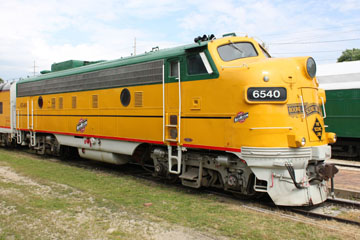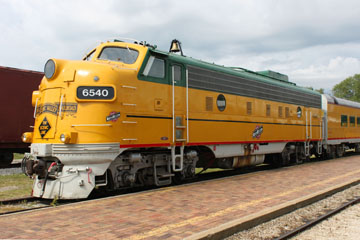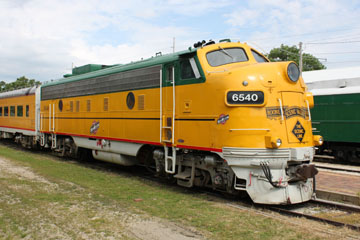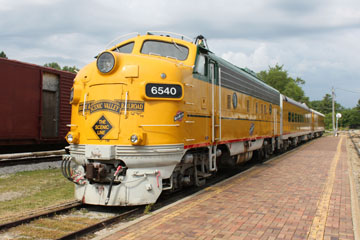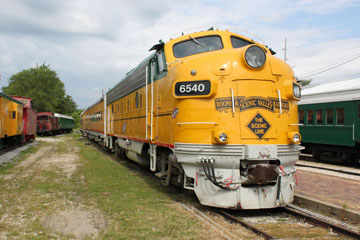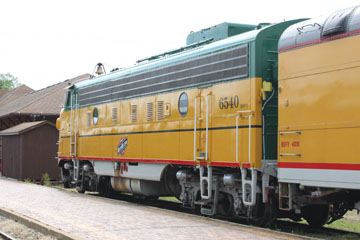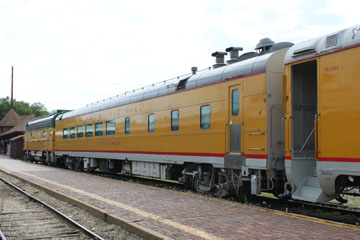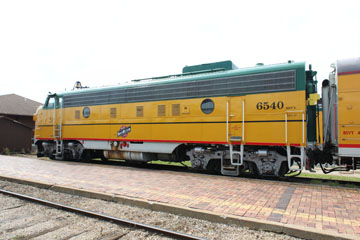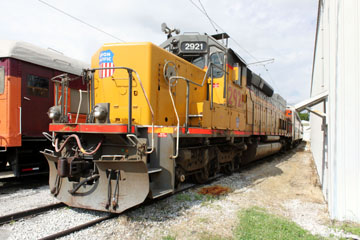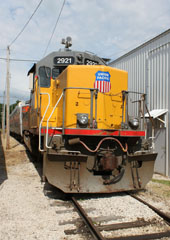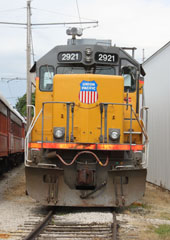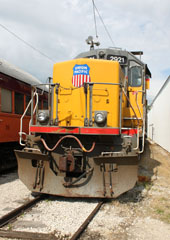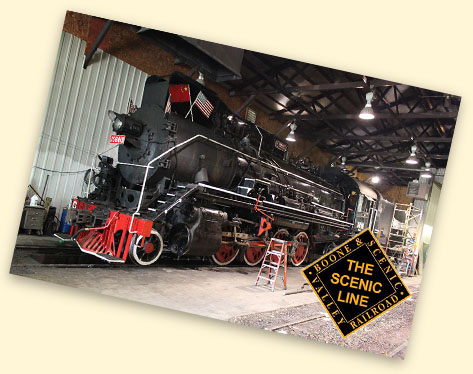

The Boone & Scenic Valley Railroad is headquartered in Boone, IA. The tourist railroad was started in 1983 by a group of volunteers who wanted to preserve a section of the former Fort Dodge, Des Moines & Southern Railroad.
The first section of track that was to become the FDDM&S started in Fraser, IA, in 1893. Fraser was the centre of newly-discovered coal deposits, and transportation was needed to move the coal. A line was built west from Fraser to connect with the Minneapolis & St. Louis Railway at what is now called Wolf.
The FDDM&S was incorporated in 1906, and the track was electrified in 1907. It was the longest interurban in Iowa and, at its height, interurban trains operated on an hourly basis. As automobile traffic increased, the passenger service was cut back, although the freight business continued to do well. In 1954, after flooding damaged the Fraser power plant that provided electricity to the line, the railroad turned to diesel motive power. The interurban cars made their last trips in August 1955, the electric lines were removed and diesel engines took over handling the freight business.

Excursions depart from the Boone depot daily from Memorial Day weekend through to the end of October. BSVY JS #8419 hauls steam trains on most Saturdays, extra dinner, dessert and picnic trains run at weekends and a trolley car runs into downtown Boone on most Saturdays.
As well as headquartering the Boone & Scenic Valley Railroad, the depot building also houses the James H. Andrew Railroad Museum & History Center, featuring a research library, theater and displays of memorabilia from all eras of railroading in Iowa.
The Chicago & North Western bought the FDDM&S in 1968 and, shortly after, began putting parts up for abandonment, although service continued to a handful of grain elevators and shippers until 1983 when the C&NW announced it was scrapping the line. That year, an eleven mile section was bought by the Boone Railroad Historical Society for $50,000.
In February 2002, the Union Pacific donated 1.7 miles of the only remaining right-of-way from the FDDM&S, and the Boone Scenic began to provide freight services.


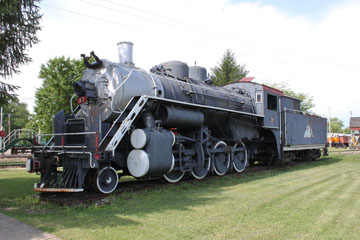
#17 was one of the last steam engines built in North America other than for military use, and one of the last used in revenue service in the US. This Consolidation type (2-8-0) locomotive was built by the Canadian Locomotive Company in Kingston, ON, in 1940 for the Roberval & Saquenay mining railroad in Northern Quebec.
The R&S had its beginnings with the incorporation in 1908 of the Ha! Ha! Bay Railway to build from Jonquieres to Bagotville on Ha! Ha! Bay, QC, with branches to Chicoutimi Pulp Company mills, to Lake Kenogami and St. Alexis.
The Roberval & Saquenay itself was incorporated in Quebec in 1911 to build from Roberval on the Quebec & Lake St. John Railway around Lake St. John to rejoin the Q&LSJ at Chicoutimi and also at St. Bruno via a branch. It bought the Ha! Ha! Bay in June 1914.
As built, #17 weighed 235,400 lbs, 210,560 lbs on
its 57” drivers. With Stephenson valve gear and
23” x 30” cylinders it had a total heating surface of 2,883 sq ft, including 564 sq ft superheating. Operating at a boiler pressure of 200 psi, it delivered 47,332 lbs tractive effort.
#17 was the last steam locomotive used for common carrier freight service in the US, making its last scheduled trip on 8th September 1986. In 1987, it was sold to the B&SV and has since had Its jacket, insulation, grates, turbo generator, bell, piping and cab appliances removed and placed in storage.
To make it operational again it would need a new whistle, flues, fire brick, boiler jacket and insulation, bottom part of the fire box water legs and mud ring, as well as main bearing work and smoke box rebuilding.
#17 worked on the R&S until retired in 1970. A tourist line, the Crab Orchard & Egyptian in Marion, IL, then bought it in 1975.
Apparently, before the CO&E's shop crew had a chance to prepare the locomotive for passenger service, a depot fire in 1977 led to a decision to operate as a freight-only line. Seeing an opportunity offered by the newly arrived 2-8-0 in the yard, the CO&E restored it to service without its superheater or feedwater heater. It was originally equipped with a winterised cab and stoker, which were also removed by the CO&E. Its headlight was from an ex-IC electric trailer car.

From 1986, a modified design, the JS "B", was produced. This incorporated a number of modifications aimed at easing maintenance and making the locomotives more suitable for short trips and switching. Four hundred and twenty-three of the JS "B" class were built before steam production ceased at Datong in December 1988.
The JS worked all over the China Rail network until the end of steam. Many of the 1980s engines then went into industrial service, and a considerable number were still operating at the turn of the century.
In 1988, the B&SVR ordered a JS Class Mikado type (2-8-2) locomotive from the Datong Company in China, which was delivered in 1989. It cost $350,000, including a shipping cost of over $100,000. The railroad operates this locomotive three times a day on weekends and public holidays from Memorial Day through the last weekend of October.
The JS was a product of co-operation between China and the USSR in the 1950s. The rolling chassis of the successful JF class Mikado was improved and paired with a new boiler based on a Soviet design to produce a mixed traffic locomotive. It went into production at Dalian in 1957 and at Qishuyan, Datong and Beijing in later years. The new engines were intended for main
line service and were equipped with mechanical stokers and feedwater heaters, resulting in a considerable increase in power over their predecessors.
Between 1957 and 1965, one thousand, one hundred and thirty-five of the class were constructed. Datong started building JSs again in 1981 and had constructed three hundred and fifty-eight more engines to the original design.
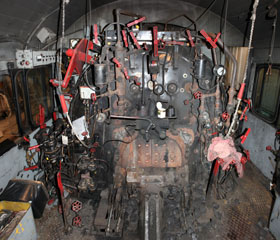
#8419 weighs 229,280 lbs, 176,370 on
its 54” drivers. It has an engine wheel base of 33’ 5” and a driver wheel base of 14’ 6”. With 22.83” x 27.95”
cylinders, it operates at a boiler pressure of 200 psi delivering 56,770 lbs tractive effort.
The front wreath, which is currently in storage, says "We are friends in the world. Even though our two countries are far apart we feel like close neighbours". On the tender on the engineer's side it translates as "The (locomotive is a) dragon that swims through the blue ocean between two friendly nations”, and the fireman’s side says, "The locomotive bounds through the sky (as if flying) as it climbs the hill and passes through the valley with a loud whistle".
The engine takes about six hours to start up when "cold" and about two hours when "warm". Each run consumes about 1,500 gallons of water and just under 1 ton of coal.

This EMD NW2 diesel-electric was built in 1942 for the Canadian National Railway subsidiary the Grand Trunk Western as #7914. Retired in the early 1970s, it was sold to Precision National Corporation in Mount Vernon, IL, where it was rebuilt and sold to the Chicago & North Western in 1973. In March 1986, it was bought by the B&SVR.
Weighing 248,000 lbs and 44' 5" long, the NW2 has an EMD 12-567 prime mover powering a GM D15C generator to drive four GM-D37 traction motors. It develops 62,500 lbs starting tractive effort at 30% and 31,000 lbs continuous tractive effort at 11 mph.

This locomotive was one of forty-three FP9A diesel-electric units (#6500-#6542) built in 1958 for the Canadian National Railway by General Motors Diesel in London, ON, a subsidiary of the Electro Motive Division of General Motors. Thirty-eight FP9B units were also purchased from GMD by the CN (#6600-#6637).
The FP9 is essentially EMD's freight hauling unit, the F9, with a four foot extension of the body behind the cab to provide room for a steam generator and water capacity for heating passenger trains.
Weighing 259,000 lbs and 54' 8" long, the FP9 has
a GM 567C 16 cylinder prime mover powering a
GM D12D generator to drive four GM-D37 traction motors. It develops 64,000 lbs starting tractive effort at 25% and continuous tractive effort of 40,000 lbs at 9.3 mph with a top speed of 65 mph.
#6540 was later used on Canada's VIA Rail passenger system. It was retired in 1991. Purchased by the B&SV in 2002, it has been liveried in a scheme similar to the Chicago & North Western’s. It is used to power the B&SVR’s dinner, dessert and picnic trains.

The radio control equipment allowed the units to work as
helpers over the mountains of the Southwest.
#2921 is equiped with an EMD 645E3 16 cylinder prime mover, an AR10 generator and six D77 traction
motors.
This SD40T-2 unit was built by EMD in June 1979 for the Southern Pacific as #8385.
Three hundred and twelve of these units were built by EMD between 1974 and 1980. The major differences from a standard SD40-2 were the low radiator intakes and radiator fan grills located at the rear of the locomotive. These allowed more fresh, cool air to enter and fewer hot exhaust fumes to linger in tunnels. The SP 8300 series also featured extended noses for radio control equipment and were therefore referred to as “snoots” and “alligators”.
Following the Union Pacific/Southern Pacific merger #8385 was renumbered UP #4476 and then #2921 in 2001. It was retired in 2008, by which time the unit had run up over 2.5 million road miles.
In February 2010, the UP donated #2921 to the B&SVR.

Originally numbered #7858, this unit was built for the US Air Force in 1942 by General Electric. In 1983, the Air Force deemed the locomotive
surplus, and it was bought by the B&SVR. In
1984, the unit was repainted and renumbered #2254, representing the number of people who bought charter memberships in the B&SVR in
1983.
In 2012, the unit was repainted using a paint scheme familiar to many along the Fort Dodge
Line as well as other Salzburg family-owned lines of the time.


